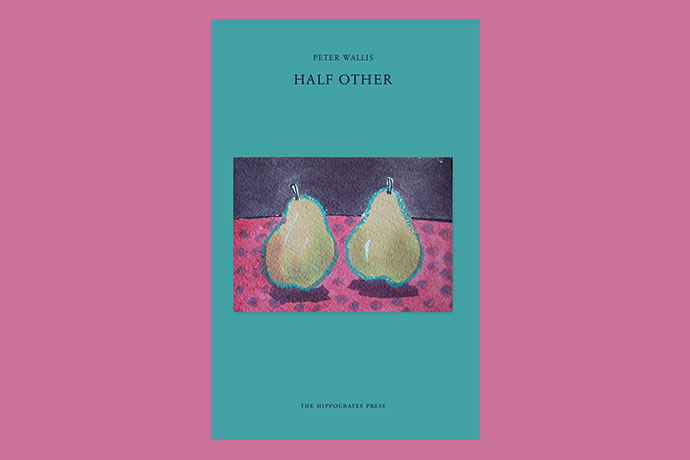Nicola Healey reads the new poetry collection by Peter Wallis: Half Other, ‘a reminder of the significance of lateral relations in our lives’ whole’.
‘I was not born alone’: Twinhood and Illness
Peter Wallis’s first full collection, Half Other, takes inspiration from his life as a twin, focusing on the lengthy ill health and hospital treatment of his brother, John, and the impact this has on Peter. I haven’t come across a collection solely on twin experience before, and it made me wonder how many poets are twins. There are the American identical twins, Matthew and Michael Dickman; Kim Moore is a twin; and I was recently struck by Tom Bailey’s poem ‘The dead twin and I are housemates now’ (Poetry News, Spring 2023), which is haunted by his unborn twin. There is certainly room for more poetry on twinship by twins (rather than by observers) – not only to represent the way they experience life differently to ‘the single-born majority’,1 but because it offers a unique opportunity to probe complex issues surrounding identity, sameness, individuality and siblinghood, all of which become concentrated in the phenomenon of twins.
The first half of Half Other explores the brothers’ schooling and childhood. Some of these poems brought back memories of mine that I’d forgotten (I’m an identical twin too). In ‘Queueing’, ‘Queuing up for lunch / the twins are double letters in a class-long word’ (a lovely, unusual image); in ‘Desks’ ‘The twins sit side by side / like rival supermarkets’ (I’m not convinced by the idiosyncrasy of that simile – it feels too much of a leap in sense for poetic novelty, though I get the idea of competing for a ‘consumer’s’ attention, wanting to stand out from your twin); and, in ‘“Children’s Shoes Have Far to Go.”’, they are ‘the innocent Start-Rite twins, taken / to try on shoes’, appearing ‘almost indistinguishable’ to the shoe fitters.
Divergence & Conflict
Wallis only lightly hints at the conflicts that twinship brings, especially in one’s formative childhood, full of ‘which is which’ confusions that are usually laughed off by others with no thought for how this affects the growing twin (these days, we could frame such slights as micro-aggressions, if it helps in understanding their impact). In ‘Dressed to the Nines’, ‘Mrs. Whitlock’ ‘carefully articulates / that in English Literature // one twin / is better than the other // but she can’t say which.’ It is dispiriting and distancing not to feel seen and known as an individual by those who should know you; or to have your ability recognised, but somehow dissociated from you. It perhaps unsettles the teacher’s authority that this identification feels beyond her expression.
While there are touching, thought-provoking moments here, the second half – on John’s diagnosis with a life-limiting brain cyst, his brain scans (twenty-three of them) and repeated brain surgery – is the more compelling half. This strength is augured by the poem which closes part I, ‘“Children’s Shoes Have Far to Go.”’, a deeply moving poem, formally tight and charged with controlled emotion. Here, Wallis traces the fundamental divergence in their twinned paths: ‘As we grew, you tangled with all things medical – / appendicitis, broken arm’; and then, ‘in your prime’, something darker beckons: ‘you were besieged by “cyst”, / “benign” and “loss of peripheral vision”.’ John becomes ‘a changed man – your face stove in, / blind, forgetful, drug-dependent, hunched, bloated and vulnerable.’ This artillery of adjectives is a lesson in not overly listening to writing ‘rules’ – I wouldn’t want to kill any of these, whose brutal force is acquired through their succession. A strict editor would say ‘vulnerable’ is implicit in the rest, and yet it belongs – it is the most sympathetic. The line bombards, is overwhelmed, just as the subject’s body and the speaker’s emotions are. I thought of Robert Lowell’s strings of adjectives: ‘I am frizzled, stale and small’ (‘Home After Three Months Away’); and ‘Flabby, bald, lobotomized, / he drifted’ (‘Memories of West Street and Lepke’). Wallis highlights how traumatic it can be to helplessly watch a loved one as they become physically assailed from the inside out.
The Limits of Love
Wallis’s speaker has an admirable closeness to his brother that makes us recall those child twins, side by side in the lunch queue, in the classroom. Though still side by side in support, his twin is going where he can’t follow, physically and mentally. In ‘“Children’s Shoes Have Far to Go.”’, Wallis writes: ‘I clasp your hand and you clutch mine, aghast / as you’re brought down again, and again / struggle up’. In ‘NHS Targets’, the speaker wishes he could take his brother’s place in hospital: ‘I want to be you / so you don’t have to.’ Illness, hospitalisation and surgery, perhaps more than anything else, remind us of our essential human state, the uncrossable boundaries between the closest of relationships, and the limits of love: ultimately, we endure these crises alone.
Twins often find it uncomfortable that their appearance is so noticeably alike, and commented on. Wallis shows how it can be equally unnerving when this visual bond dissipates. In ‘“Children’s Shoes Have Far to Go.”’, the speaker’s obvious health becomes a conspicuous badge of shame, a reminder to everyone of a life his brother could have had, but for some quirk of fate: ‘I, an embarrassment of health, become your road not taken, / so when people look, they’ll seek an explanation.’ Having a twin is like having a constant control alongside you in the ‘experiment’ of your life.
Masked Suffering
This is difficult, distressing material, and it is commendable that Wallis has even been able to confront it, and in often visceral detail. It put me in mind of Hugo Williams’s frankness and spare understatement in Lines Off (Faber, 2019), a model of the hospital poetry genre. I especially appreciated ‘Craniotomy 2: An Essential Guide. Identical’, on the strain of facing people’s ‘[e]ndless enquiries’ asking after John (especially when they don’t really want to know the real answer, or if that is incommunicable). Wallis spends eleven lines graphically detailing what has happened to John and its consequences, a stifled internal monologue, and then writes:
I can’t say all this and don’t try.
For most, my normal appearance
is reassurance enough. But for us,
my untouched face is a mirror of lies.
With indefinite problems (in both senses), a person cannot wear suffering on their face continually – they cannot perform it – so they mask it. A disparity between appearances and inner torment then simmers. The speaker’s ‘normal appearance’ weighs heavy on him for the untruths it tells.
‘Hospital Bed’ is another powerful poem, employing nine similes to show how John ‘wears’ the bed, implying a lengthy recovery. The opening simile is particularly striking, suggesting a body both shielded by and trapped in the bed: ‘You wear the bed / like an exoskeleton.’ Some of the similes don’t feel necessary and are pushed too far, but the closing imagery vividly draws us back to the body’s invisible, mysterious interior and why the patient is there: ‘You wear the bed / the way a tongue wears a mouth // or a cyst wears your head.’
Object-focus
Wallis is good at showing how emotionally wearing lengthy illness and treatment can be for relatives. He details six of those twenty-three brain scans, in short, pithy poems interspersed throughout the collection. Each time, Wallis writes variations of ‘you hand me your wallet’ (before John goes in for the scan), offering a different metaphor each time for what this feels like in his hand (‘Scan 12’). The most successful of these are probably in ‘Scan 12’: ‘In my palm, / it’s your heart in a casket, you in microcosm’; and, in ‘Scan 9’: ‘I wait, / holding your wallet / like the reel of a kite’ (untethered from the kite itself). This object-focus shows how one’s senses are heightened in times of waiting and concern; how a loved one’s possessions become freighted with meaning and emotion; and how we hyper-focus on apparently irrelevant concrete details in the face of the unknown, desperately trying to ground the overwhelmed self with a material focal point. This heavy oddness is felt in the first ‘Scan’ poem, where the lumpen wallet lies in the speaker’s hand ‘like a cloven hoof’, suggesting alienation and division. The inanimate wallet becomes a symbol, an objective correlative, for all that the twins are going through; perhaps it even represents the brain cyst itself. The repetition of this wallet imagery very effectively conveys the relative’s forlorn futility ‘in the wings’: each time, all he can do is stand by as his brother undergoes more investigation: ‘I hold your wallet’ (‘Scan 23’).
As a believer (initially sceptical) in the powers of mindfulness to alleviate suffering, if only sporadically, I was glad to read in ‘Mindfulness’ that being ‘more like a Buddhist’ eased John’s symptoms after six months, enabling a ‘sudden improvement after twenty-three years’. It ‘seems miraculous’, Wallis writes, ‘and if the process seems madness … who cares.’
Sidelined Siblings
Sibling bonds, let alone twinship, are not often probed in contemporary poetry; and when twins are used in fiction, it is usually as a plot device or to amuse or unsettle a non-twin audience – rarely do we see their real existential experience represented, as Jude Cook has described with great clarity and (tw)insight (his article, ‘Seeing double’, is brilliant, in the TLS, January 14, 2022). Poets more usually seem to leave siblings behind them, as if this bond poses a threat to adult individualistic self-constructions. Blake Morrison is a notable exception: his memoir Two Sisters (The Borough Press, 2023) notices how sidelined siblings are in culture, and his recent pamphlet, Skin & Blister (Mariscat Press, 2023), memorialises his sister, Gillian. I also thought of Louise Glück when reading this collection, whose last book, Marigold and Rose: A Fiction (Carcanet, 2022), imagines the inner life of baby twins, inspired by her grandchildren (though I always find a twin’s writing on twinhood more compelling, and recognisable, as they write from the inner worlds they have experienced). Half Other is a lived reminder of the significance of lateral relations in our lives’ whole, beyond the parental linear ones, and outside the romantic bond that transfixes society and art.
The Shadow of Another Life
In Siblings (Polity Press, 2003), Juliet Mitchell alludes to a political prisoner twin who ‘could not bear solitary confinement’, which caused ‘beyond-average despair’. In trying to understand this, the twin starkly wrote: ‘I was not born alone’. Only twins can answer back to the biblical proclamation, ‘For we brought nothing into this world’ – all going well, they bring each other. Half Other is ultimately about holding the shadow of another life within you, alongside the growing fear that, though they were not born alone, the brothers will likely leave life separately. I valued hearing one twin’s response to this ordeal, though it left me wanting to know John’s perspective on his own illness and treatment. At sixty-eight poems on one topic, the collection feels long, and the less resonant poems could have been removed for a more streamlined text. It feels churlish to be too critical, however, as Half Other, dedicated to Wallis’s brother, is a lifetime’s labour of sibling love, and he succeeds in showing his.
You can order Half Other by Peter Wallis (Hippocrates Press) here.

Nicola Healey’s poems, essays and reviews have appeared in The Poetry Review, Poetry London, The London Magazine, Poetry Ireland Review, Wild Court, and elsewhere. She is the author of Dorothy Wordsworth and Hartley Coleridge: The Poetics of Relationship (Palgrave Macmillan, 2012). Her first poetry pamphlet, A Newer Wilderness, is forthcoming from Dare-Gale Press in April 2024.
- This is a phrase William Viney, himself a twin, uses in his recent book Twinkind: The Singular Significance of Twins (Thames and Hudson, 2023). ↩︎

Add your Reply
You must be logged in to post a comment.